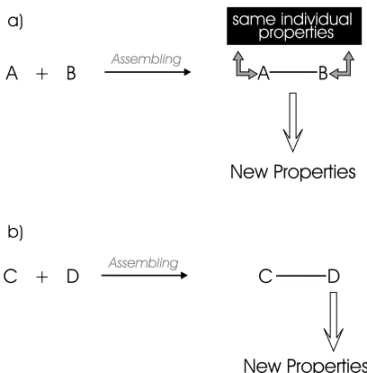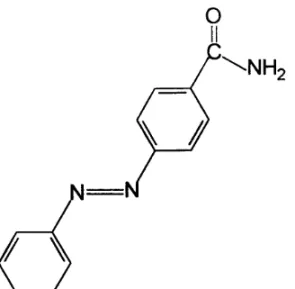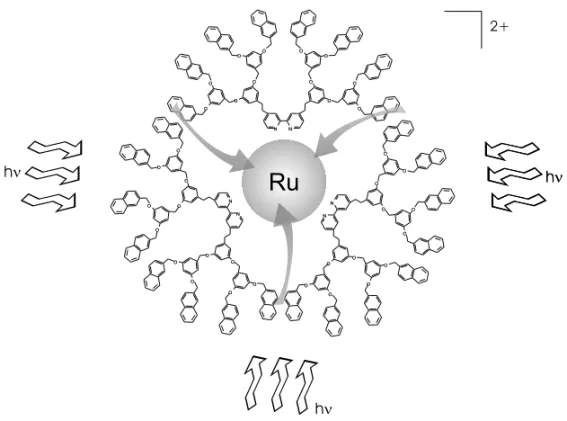GIANLUCA CAMILLO AZZELLINI
Instituto de Química, Departamento de Química Fundamental, USP, Cx. Postal 26077 – 05513-970 São Paulo, SP, Brazil
Manuscript received on September 8, 1999; accepted for publication on September 15, 1999; presented byJosé M. Riveros
ABSTRACT
In this article are described dendritic structures containing photoactive groups at the surface or in the core. The observed supramolecular effects can be attributed to the nature of the photoactive group and their location in the dendritic architecture. The peripheric azobenzene groups in these dendrimeric compounds can be regarded as single residues that retain the spectroscopic and photochemical properties of free azobenzene moiety. TheEandZforms of higher generation dendrimer, functionalized with azobenzene groups, show different host ability towards eosin dye, suggesting the possibility of using such dendrimer in photocontrolled host-guest systems. The photophysical properties of many dendritic-bipyridine ruthenium complexes have been investigated. Particularly in aerated medium more intense emission and a longer excited-state lifetime are observed as compared to the parent unsubstituted bipyridine ruthenium complexes. These differences can be attributed to a shielding effect towards dioxygen quenching originated by the dendritic branches. Key words:Supramolecular Photochemistry, Dendrimers, Azobenzene, Ruthenium Complexes.
I. INTRODUCTION
The combination of molecular components leads to
supramolecularspecies and one of the most inter-esting aspects of the chemistry of supramolecular systems is their interaction with light ( supramolec-ular photochemistry) (Balzani & Scandola 1991). The assembly of components in a supramolecular system containing photoactive groups can produce two main effects (Fig. 1):
a) The individual components retain their intrin-sic properties but the whole specie has new properties.
b) Some of the constituents of the assembled species have new properties.
In the first case there is no strong electronic interaction between the components of the molec-ular assembly, but in comparison with the individ-ual components, a new microenviroment or steric
E-mail: gcazzell@quim.iq.usp.br
modifications are created. In this class of systems, in general, a photocontrolled host-guest behavior is observed as in functionalized crown-ether (Shinkai
et al. 1981) or cyclodextrin (Ueno et al. 1979) molecules. In the second one there is a significant electronic interaction between the assembled com-ponents or, alternatively, nuclear constraints that change the photophysical properties of the individ-ual components are introduced, as in the case of many polynuclear (Bignozzi & Scandola 1984) and caged (Pinaet al.1985) metal complexes.
In this short review supramolecular systems, based on dendritic structures containing photoac-tive groups will be described. The supramolecular effects, mentioned above, can be attributed to the nature of the photoactive groups and their location in the dendritic architecture.
II. DENDRITIC SYSTEMS CONTAINING PERIPHERAL AZOBENZENE GROUPS
con-DENDRITIC SYSTEMS WITH PHOTOACTIVE GROUPS 34
Fig. 1 – Supramolecular Effects: a) Week electronic/nuclear interaction leads to the maintenance of the individual properties; b) appreciable electronic/nuclear interactions leads to changes in the individual properties.
structed from an initiator core upon wich radially branched layers, termed generations, are covalently attached. As a result of the particular shape of den-dritic molecules and the way branches propagate, three main regions can be defined in this class of compounds: a core, internal cavities and a surface. Recently, the preparation of two isomeric families of poly(propylene imine) dendrimers, containing at the surface para (p) and meta (m) carboxamide-substituted azobenzene units as peripheral end groups, was described (Archutet al. 1998a). The total number of azobenzene residues for the first, second, third and fourth generations (G1 to G4) is respectively 4, 8, 16 and 32. Fig. 2 shows the struc-ture of the para-substituted G4 generation and the two para and meta model compounds, that will be simply called monomers.
All dendritic compounds exhibit the same ab-sorption maximum for theπ−π∗andn−π∗bands
as for the corresponding monomer derivatives. The molar absortivities values, taking into account the experimental uncertainties, increase for each fam-ily according to an arithmetic progression, indicat-ing that the overall molar absortivity corresponds to the addition of the molar absortivity of each single
switched to theZform by light of appropriate wave-length and can be converted back to theEform by either irradiation or by heating. Despite the decrease of quantum yields with increasing dendrimer gener-ation, the quantum yield for each single photoactive unit is not dependent on the number of such units in the species.
The above mentioned spectroscopic and pho-tochemical results indicate clearly that there is no strong interchromophoric interactions and/or effec-tive steric hidrance in the surface region of such com-pounds. The azobenzene units in these dendrimeric compounds can be regarded as single residues that retain the spectroscopic and photochemical proper-ties of the free azobenzene moiety.
In principle, the access of guest molecules to the internal cavities of the dendritic compounds can be controlled by surface isomerizable azobenzene groups, since there is a large structural rearrange-ment in going from the E to the Z isomer (Rau 1990).
Two distinct situations can be found, as repre-sented schematically in (i), where the open and close forms of the surface correspond respectively to the linearEand bentZisomers:
OPEN CLOSE
The host ability of these compounds towards eosin dye has been studied (Archutet al.1998b). Both the
EandZforms of the dendrimers quench the eosin fluorescence by a static mechanism. The quenching is most likely due to an electron-transfer reaction between the singlet excited state of eosin and the ter-tiary amine units present along the branches of the dendrimers. Quenching by theZform is more effi-cient than quenching by theEform. These results indicate that eosin is hosted by the dendrimers and suggest the possibility of using dendrimer deriva-tives in photocontrolled host-guest systems.
III. METAL COMPLEXES CONTAINING DENDRITIC BIPYRIDINE LIGANDS
The complexes of the [Ru(bpy)3]2+ family (bpy=
DENDRITIC SYSTEMS WITH PHOTOACTIVE GROUPS 36
Fig. 3 – Schematic representation of ligth absorption and energy-transfer processes in the naphthalene substituted dedritic-bpy ruthenium(II) complex.
erties and in the excited state reactions with en-ergy/electron transfer quenchers. In deaerated so-lution, higher generation bpy-dendrimer complexes exhibit a more intense emission and a longer excited-state lifetime as compared to the parent unsubsti-tuted [Ru(bpy)3]2+complex under the same
condi-tions. The most interesting features are observed in aerated solution. The same trends in the photophysi-cal properties are observed but in a remarkable way. For example, the excited-state lifetime of a ruthe-nium (II) complex containing 54 peripheral methyl esther groups in aerated and deaerated medium is re-spectively, 6 and 1.7 times greater than that for the parent unsubstituted [Ru(bpy)3]2+. The differences
can be attributed to a more rigid microenviroment at the core and to a shielding effect towards dioxygen quenching. A drastic decrease is also observed, in the bimolecular quenching rate constants, for the re-actions of many bpy-dendritic ruthenium complexes and neutral, cationic and anionic electron-transfer quenchers (Vögtle et al. 1999). The above men-tioned results show that the dendritic ligands are im-portant as modulators of the central core behaviour. Another interesting feature of this class of den-drimers, containing a central [Ru(bpy)3]2+unit, is
reactive groups such as energy donor species. A simple model for the photosyntetic antenna system (Gust 1990), was build up by coordination of naph-thalene substituted dendritic-bpy to Ru2+ ions (Azzellini 1998). In this case, the reaction center and the energy collectors are represented, respec-tively, by the single [Ru(bpy)3]2+ unit and
naph-thalene groups. The number of this energy donors is, as expected, dependent on each dendrimer gen-eration. An efficient energy transfer process is achieved, when the samples are excited at the ab-sorption band region of the aromatic units, as indi-cated by the quenching of naphthalene fluorescence (Plevoetset al.1999), reproducing some aspects of the natural systems.
REFERENCES
Archut A, Azzellini GC, Balzani V, De Cola L & Vögtle F 1998a. Azobenzene-Functionalized Cascade Molecules: Photoswitchable Supramolecu-lar Systems.Chem Eur J 4:669-706.
Azzellini GC, De Cola L, Balzani V, Issberner J, Ploenvets M & Vögtle F 1998. Synthesis and Luminescence Properties of Dendrimeric Ruthe-nium(II) Complexes. XXXIII International Confer-ence on Coordination Chemistry, Abstract. Book: 151p.
Balzani V & Scandola F 1991. In: Supramolecular Photochemistry, Ellis Horwood, Chichester.
Bignozzi CA & Scandola F 1984. Cyano-Bridged Ruthenium(II)/Platinium(II) Complexes: Synthesis, Photophycal Properties and Excited-State Redox Be-havior.Inorg Chem 23:1540-1545.
Gust D & More TA 1990. Photosynthetic Model Sys-tems.Top Curr Chem 159:103-152.
Issberner J, Vögtle F, De Cola L & Balzani V 1997. Dendritic Bipyridine Ligands and Their Tris(bipyridine)Ruthenium(II) Chelates: Syntheses, Absorption Spectra, and Photophysical Properties.
Chem Eur J 3:706-712.
Juris A, Balzani V, Barigelletti F, Campagna S, Belser P & von Zelewsky A 1988. Ru(II) Polypiridine Complexes: Photophysics, Photo-chemistry, Electrochemistry and Chemilumines-cence.Coord Chem Rev 84:85-277.
Newkome GR, Moorefield CN & Vögtle F 1996. In: Dendritic Macromolecules: Concepts, Synthe-ses, Perspectives. VCH, Weinheim.
Pina F, Ciano M, Moggi L & Balzani V 1985. Electron-Transfer Photosensitization via Ion-Pairs. Co(Sepulchrate)3+−Iodide Ion. Inorg Chem 24: 844-847.
Plevoets M, Vögtle F, De Cola L & Balzani V1999. Supramolecular Dendrimers with a [Ru(bpy)3]2+ Core and Naphthyl Peripheral Units. New J Chem
23:63-69.
Rau H 1990. Azo Compounds. In: Dürr H, Bouas-Laurent H. eds. Photochromism, Moleculesand
Systems.Amsterdam, Elsevier, p.165-192.
Shinkai S, Nakaji T, Ogawa T, Shigematsu K & Man-abe O 1981. Photocontrol of Ion Extraction and Ion Transport by a Bis(Crown-Ether) with a Butterfly like Motion.J Am Chem Soc 103:111-115.
Ueno A, Yoshimura H, Saka R & Osa T 1979. Photo-control of Binding Ability of Capped Cyclodextrin.
J Am Chem Soc 101:2779-2780.


